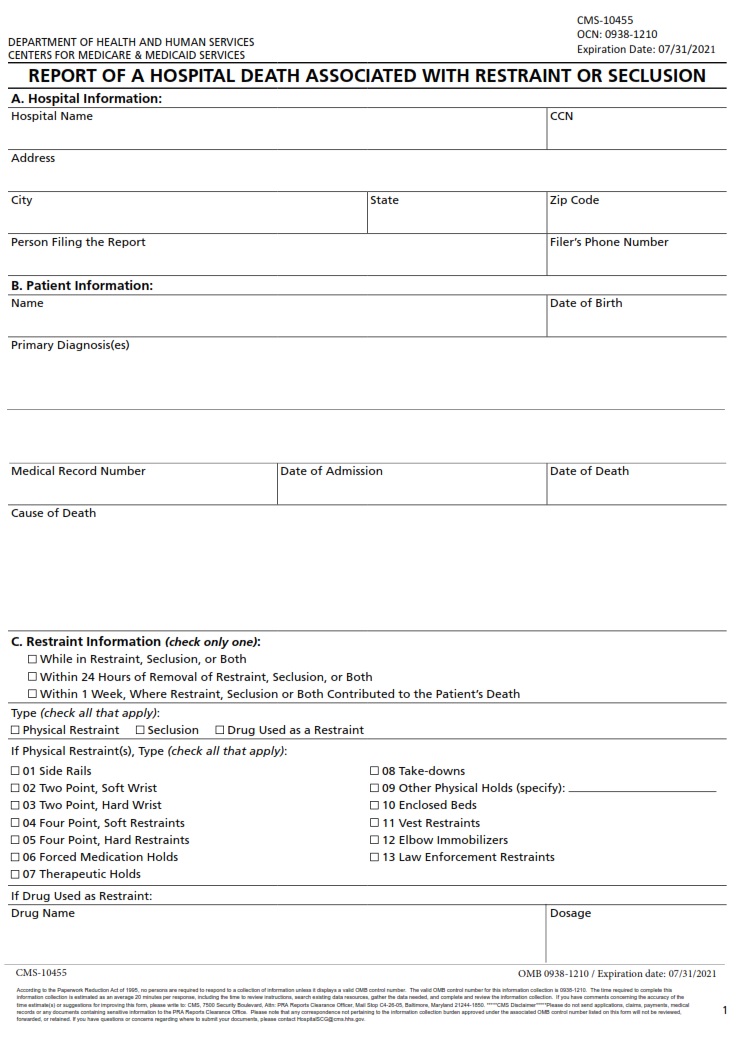CMSFORM.ORG – CMS-10455 – Report of a Hospital Death Associated with Restraint or Seclusion – In the hushed corridors of a hospital, where life and death dance in a delicate balance, there exists a practice that strikes fear into the hearts of patients and caregivers alike: restraint or seclusion. CMS-10455 stands as a chilling reminder of the potential consequences when these measures are misused. In this report, we delve into the tragic tale of a hospital death shrouded in controversy and intrigue, exploring the fine line between patient safety and violation of human rights. Join us on a journey through the shadows of healthcare ethics as we unravel the mysteries behind this haunting case, shedding light on an issue that demands our attention and introspection.
Download CMS-10455 – Report of a Hospital Death Associated with Restraint or Seclusion
| Form Number | CMS-10455 |
| Form Title | Report of a Hospital Death Associated with Restraint or Seclusion |
| Published | 2018-07-19 |
| O.M.B. | 0938-1210 |
| File Size | 116 KB |
CMS 10455 - Report of a Hospital Death Associated with Restraint or Seclusion (1017 downloads )
What is a CMS-10455?
In the healthcare industry, the CMS-10455 form holds significant weight as it documents instances of hospital deaths associated with restraint or seclusion. This report serves as a vital tool for ensuring transparency and accountability in patient care practices within medical facilities. By documenting such incidents, healthcare providers can identify areas for improvement and work towards implementing safer protocols to prevent future occurrences.
The completion of a CMS-10455 report not only sheds light on the tragic event of a patient’s death but also prompts medical professionals to critically assess their methods of using restraints or seclusion. This process encourages hospitals to prioritize patient safety and foster a culture of continuous learning and development in providing compassionate care. Overall, the significance of this report lies in its role as a catalyst for change in how healthcare institutions approach the delicate balance between maintaining safety measures and respecting patients’ rights and well-being.
Where Can I Find a CMS-10455?
A CMS-10455 report documenting a hospital death associated with restraint or seclusion can provide valuable insights into patient safety and the need for proper protocols in healthcare settings. As these reports are crucial for identifying areas of improvement, finding a copy can be essential for healthcare providers looking to enhance their practices. One key source for obtaining this report is through the Centers for Medicare & Medicaid Services (CMS) website, where individuals can access official documentation related to patient safety incidents.
In addition to the CMS website, hospitals and healthcare facilities may also have copies of CMS-10455 reports available upon request. By reaching out to the appropriate departments within these institutions, stakeholders can gain access to important information regarding past incidents involving restraints or seclusion that led to adverse outcomes. Furthermore, sharing and analyzing these reports internally can facilitate discussions on best practices and strategies to prevent similar events from occurring in the future.
CMS-10455 – Report of a Hospital Death Associated with Restraint or Seclusion
The unfortunate event of a hospital death associated with restraint or seclusion, as detailed in CMS-10455 report, highlights the critical need for proper protocols and vigilance in healthcare settings. Implementing appropriate training programs for staff members on de-escalation techniques and alternatives to restraint can significantly reduce the risk of such tragic outcomes. Moreover, fostering a culture of open communication and transparency within healthcare facilities is crucial to prevent similar incidents from occurring in the future.
It is imperative for hospitals to prioritize patient safety above all else and constantly assess their practices to ensure compliance with regulations regarding the use of restraint and seclusion. Understanding the delicate balance between patient autonomy and safety is crucial in providing compassionate care while minimizing harm. By learning from past incidents like the one documented in CMS-10455, healthcare institutions can work towards creating safer environments for patients, where their dignity and well-being are always at the forefront of decision-making processes.
